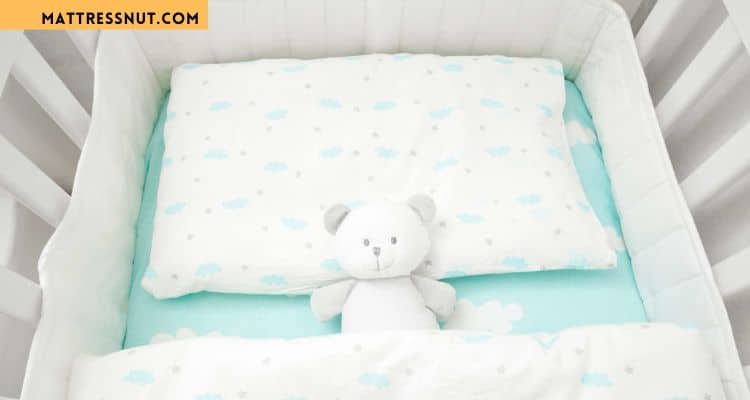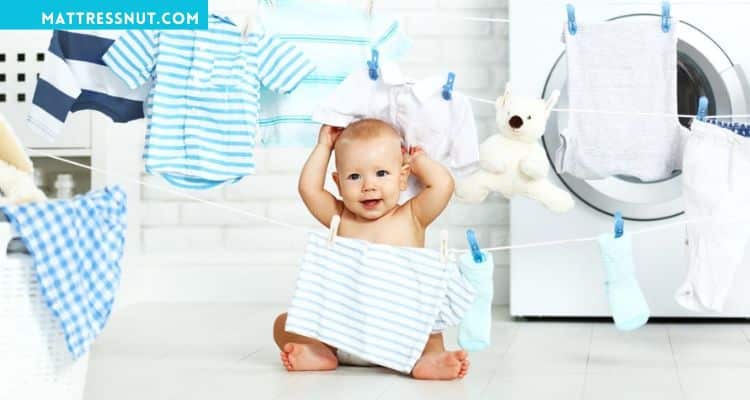When preparing for a newborn, you’ll probably ponder, How many crib linens will you need?
That is an excellent question!
Nobody wants to squander money on baby products they will never use, but no one wants to be caught short!
That’s why we put up this crib sheet shopping guide to help you determine the number of crib sheets you’ll require when your little one comes.
Determining the Number of Crib Sheets You Need
The amount of crib sheets required for a crib bed might vary based on several factors. The following are a few factors to consider when determining the amount of crib linens you need.

Recommended Minimum Number of Crib Sheets for Practicality and Convenience
The bare minimum count of fitted crib sheets you require is three: one in the crib, another in the wash, and one spare. Therefore, you will not have to do laundry every day. Extra crib sheets will be on standby for routine sheet changes and unexpected dirty situations.
Frequency of Sheet Changes
The answer to this question depends entirely on your baby’s specific requirements. However, we recommend changing your infant’s cot sheet once or twice weekly. But of course, you must change the sheet immediately if any accident ruins it. It’s generally a good idea to have a couple of extra crib linens accessible in case anything unexpected occurs.
Dealing With Unexpected Messes and Accidents:
Having extra crib bedding on hand is beneficial for dealing with unanticipated mess effectively. This lets you immediately change the damaged sheet while cleaning the stained one. Additionally, having additional crib sheets on hand might save you both time and worry when an accident occurs.
Benefits of Having Multiple Crib Sheets
Multiple crib linens are convenient and time-saving. Accidents, spillage, or diaper leakage can occur with infants, resulting in a contaminated crib sheet. If you have spare sheets, you may change the filthy ones without washing or cleaning them. This is particularly useful at night or during naps when you might not have the option of additional time or energy.
Furthermore, having numerous crib sheets lets you experiment with patterns, colors, and designs to personalize your baby’s room. You can choose linens that complement the room’s overall aesthetic or switch them out periodically for a new appearance.
Different Types of Crib Sheets:
There are several materials to pick from when purchasing crib linens. Each material has distinct advantages and disadvantages. Here are several of the most popular varieties of crib sheets:
Cotton and Organic Cotton
Cotton is a popular material for crib linens since it is lightweight, breathable, and long-lasting. Organic cotton is superior because it grows without the addition of potentially dangerous chemicals. Cotton crib sheets are simple to care for and available in various colors and designs.
Bamboo and Muslin
Bamboo and muslin crib linens are getting more popular because of their soft, breathable, and hypoallergenic properties. Bamboo is environmentally beneficial since it grows swiftly and does not need pesticides. Muslin is a cotton-based fabric that is thin and breathable, rendering it an excellent option for hotter temperatures.
Fleece
Fleece crib linens are a fantastic option for colder spaces since they’re extremely cozy and cuddly. They are silky and sturdy, which makes them a good choice for infants who enjoy cuddling. However, since fleece is not as breathable as other textiles, there may be better options for hot climates.
When selecting a crib sheet, keep your baby’s requirements in mind and the environment in which you reside. These substances are safe for infants and can help create a cozy resting environment.
Laundry and Drying Time
As a result of spit-up and diaper blowouts, you must launder the cot linens more frequently than standard sheets. The NHS advises washing at an increased temperature of 60 degrees to guarantee no dust mites or germs are left behind.

Furthermore, three fitted crib linens aren’t enough if you perform a weekly washing wash, particularly if you have a kid that throws up a lot. You’ll need sufficient fitted baby sheets to last a week without washing them. Keeping at least four crib sheets on hand is advisable in case of an unexpected quick change.
Budget Considerations
Before purchasing baby linens, it is essential to determine your budget. Setting a budget can assist you in narrowing your selections and making smarter shopping decisions.
While the budget is crucial, you must decide what attributes and features are necessary for baby linens. These may include things like correct fit, cleaning convenience, and durability. Find linens that fit these requirements while staying within your budget.
Traveling with Your Baby
Extra crib sheets are vital if you often travel with your infant or if your kid spends the night at a caretaker’s home. It guarantees you can bring a clean sheet to each place, ensuring your baby’s comfort and cleanliness despite where they sleep.
Extending the Lifespan of Your Crib Sheets
Below are some care and maintenance suggestions for preserving the quality and longevity of your cot sheets:
- Regular Washing: Make a habit of cleaning your crib linens regularly, particularly if your baby has mishaps or spills. Wash them once every 1-2 weeks or more often if necessary. Remove any marks or spills as soon as possible to keep them from settling in.
- Gentle Washing Cycle: When washing crib linens, gently or delicately. This helps to avoid excessive agitation and reduces the danger of fabric or seam damage.
- Use Mild Detergent: When washing crib linens, use a gentle, baby-safe detergent. Harsh detergents could irritate your baby’s skin and harm the fabric over time. Choose detergents that do not include colors, perfumes, or harsh chemicals.
- Rotate and Alternate Sheets: Rotate and alternate the usage of your crib sheets to equally distribute wear and tear. This prevents excessive use of each sheet and prolongs its overall durability.
Conclusion
In conclusion, there is no correct or incorrect number of crib linens that you will need. Four to five linens might be enough if you’re a parent who washes laundry often. However, having a few extra sheets is not a bad idea. Considering the factors above should help you decide how many crib sheets you need.
How Many Crib Sheets Do I Need? FAQs
How Many Crib Sheets Do I Need for My Baby?
For your infant, you will need a minimum of three crib sheets—one for your crib, one for the laundry, and one extra. However, if you don't wash laundry daily, we suggest purchasing five to seven to keep everything in order.
How Often Do I Need to Change Crib Sheets?
The frequency of altering crib sheets depends on the infant's habits, mishaps, and cleanliness. However, we suggest replacing crib linens at least once every week if no incidences occur and more often if necessary.
Are There Any Specific Guidelines for the Number of Crib Sheets to Have?
While there are no strict guidelines regarding the precise amount of crib sheets you need, having at least 2-3 crib sheets is often advised. However, depending on your unique requirements and circumstances, you may opt to have more.
